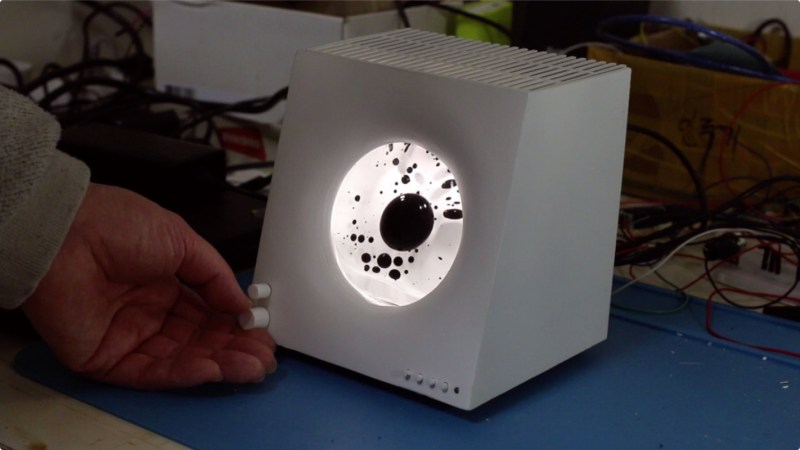Ferrofluids, as the name implies, are liquids that respond to magnetic fields. They were originally developed for use by NASA as rocket fuel but are available to the general public now for anyone who wants to enjoy their unique properties. For [Dakd Jung], that meant building a special chamber into a Bluetooth speaker that causes the ferrofluid inside to dance along with the rhythm of the music.
This project isn’t quite as simple as pushing the ferrofluid container against a speaker, though. A special electromagnetic device similar to a speaker was used specifically to manipulate the fluid, using a MSGEQ7 equalizer to provide the device with only a specific range of frequencies best tailored for the fluid’s movement. The project includes two speakers for playing the actual music that point upward, and everything is housed inside of a 3D-printed case. There were some additional hurdles to overcome as well, like learning that the glass needed a special treatment to keep the ferrofluid from sticking to it.
All in all it’s a unique project that not only brings sound to a room but a pleasing physical visualization as well. Being able to listen to music or podcasts on a portable speaker, rather than the tinny internal speakers of a phone or laptop, is the sort of thing you think you can live without until you get used to having higher quality sound easily and in every place you go. And, if there’s a way to improve on that small but crucial foundation with something like a dancing ferrofluid that moves with the music the speaker is playing, then we’re going to embrace that as well.
















https://www.youtube.com/watch?v=7a3JiGTE9sc
Not the Hero we deserve, but the Hero we need.
To me this looks violent…. like an invisible force beating an octopus… nahhh… the ferrofluid clock was nicer to watch!
This guy went the distance to make this arcane and thoroughly mesmerizing effect from a fascinating material, but … “originally developed for use by NASA as rocket fuel”.
SAY WHAAAAT?
I thought it was for cooling the voice coils of high powered loudspeakers.
Yeah, I found a reference on the NASA site to a first application in 1980 in the petrol industry. Maybe that’s what they saw?
https://spinoff.nasa.gov/Spinoff2018/cg_3.html
>In the early 1960s, Steve Papell, an engineer at Lewis Research Center, now Glenn Research Center, came up with the idea of magnetizing rocket fuel as a way to draw it from a storage tank into an engine in the absence of gravity. He discovered a way to stably disperse magnetic nanoparticles throughout a carrier fluid, making the first ferrofluid. A few years later, a company called Avco Space Systems won a NASA contract to further characterize and develop ferrofluid and managed to create a variety of liquids that ranged up to 10 times the magnetic strength of the initial Lewis invention.
Note the absence of rocket engines in applications (below)…
>Two Avco engineers licensed the technology from NASA to found Ferrofluidics Corporation, now Ferrotec. The material has come to be used in a variety of applications, from loudspeakers to petroleum refining and chemical processing facilities, to semiconductor chip manufacturing (Spinoff 1980, 1981, 1993, 2015).
Great Job brings me back to the original lava lamps, only better!!!
Ah, you beat me to it. 🤔
A lave lamp for the 21st century. 🤔
Love the results here but one thing I don’t get. The MSGEQ7 splits audio into 7 frequency ranges, then spits out a number which represents the volume level in each range. Coudn’t you just pick between any of the 7 frequency ranges because the way the MSGEQ7 spits it out is the same?
great job! a winamp visualisation IRL. [and looks like the ‘introduce yourself’ LP from FNM at the same time – kinda curious whether that music would produce similar effects to what’s depicted]
How to make it more lava lamp kind? Maybe it need oil?